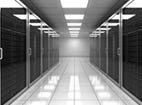The hyperscale data center industry has made no secret of its desire to leverage renewable energy to the greatest extent possible. When you start measuring density in megawatts, any solution that helps cut the power bill is welcome.
Lately, much of the activity has centered on wind, with top-tier data producers signing long-term agreements with wind farms near their newest plants, or in some cases building capacity on-site.
Google, for example, recently teamed up with Dutch utility Eneco to provide wind energy to the company’s new facility in Eemshaven in the Netherlands. The goal is to run the plant on 100 percent wind that is sourced from Eneco’s farm in nearby Delfzijl, and in fact, the data center is expected to draw the full output of the facility for the 10-year lifespan of the contract. The data center is expected to go on-line in mid-2016.
Meanwhile, Facebook recently flipped the switch at its newest center, located in Altoona, Iowa, which is also said to be fully powered by wind. Energy will be provided by a new farm in Wellsburg, Iowa, which contributes upwards of 140 MW to the regional grid. As well, the data center will employ techniques such as free cooling, which uses available air to keep rack temperatures down, and the entire infrastructure is designed around the systems and infrastructure templates the company has devised under its Open Compute Project.
And then there is Microsoft, which over the summer announced a 20-year agreement with the Pilot Hill Wind Project in Illinois to funnel 175 MW to its Chicago facility. The project is to be funded partly from the proceeds that Microsoft will gain by selling carbon offsets on the open market, and it represents Redmond’s largest investment in wind energy so far. As in other wind projects, the power is drawn from the local electric grid, which likely contains power from a mix of renewable and non-renewable sources.
These kinds of projects will no doubt become more common as more workloads shift to the cloud and the number of massive, regional data plants increases. For the average enterprise today, however, wind energy is more of an ideal than a practical reality. As “Mathematical Ecologist” Robert Wilson of the University of Strathclyde notes, reliability remains a key issue and often trumps both cost and environmentalism in the IT industry. While all power plants go off-line from time to time, the fact is that when the wind stops blowing, it stops for a long time and over a very wide area, and that means all wind farms will have to be backed up by coal, oil, gas or nuclear power. And at the moment, wind power contributes too little to the worldwide energy grid to make a real impact on either costs or the environment.
So in the end, when a hyperscale data company says it is powering its plant by 100 percent wind, it means it is paying a local utility to support current wind facilities and the development of new ones, but the actual energy it is receiving is only partly from wind – and in some cases that’s a very small part.
This is not meant to be a swipe at wind-powered data facilities or the good intentions of companies like Facebook and Google, but merely an acknowledgement that “100 percent wind-powered” is not exactly true.
Perhaps someday we will see a 100 percent renewable data center, but that change will have to come from the power utility industry, not from IT.
Arthur Cole writes about infrastructure for IT Business Edge. Cole has been covering the high-tech media and computing industries for more than 20 years, having served as editor of TV Technology, Video Technology News, Internet News and Multimedia Weekly. His contributions have appeared in Communications Today and Enterprise Networking Planet and as web content for numerous high-tech clients like TwinStrata, Carpathia and NetMagic.




